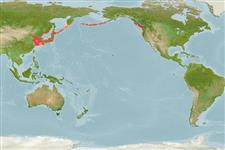Classification / Names
Common names from other countries
Main reference
Size / Weight / Age
Max length : 15.0 cm SL male/unsexed; (Ref. 559); common length : 10.0 cm SL male/unsexed; (Ref. 559)
Environment
Marine; demersal; oceanodromous (Ref. 51243); depth range 0 - 172 m (Ref. 114018)
Climate / Range
Temperate, preferred 15°C (Ref. 107945); 47°N - 29°N, 127°E - 145°E (Ref. 54280)
Distribution
Short description
Dorsal
spines
(total): 0;
Dorsal
soft rays
(total): 55-59;
Anal
spines: 0;
Anal
soft rays: 28 - 32;
Vertebrae: 62 - 67. Characterized by having a horizontal skin fold along its ventral contour, and the absence of pelvic fin and teeth. Lateral plicae 160 to 180. Lower jaw pointed. Lateral line system on head not continuous with that on the body.
IUCN Red List Status (Ref. 115185)
Threat to humans
Harmless
Human uses
Fisheries: highly commercial
More information
ReferencesAquacultureAquaculture profileStrainsGeneticsAllele frequenciesHeritabilityDiseasesProcessingMass conversion
Tools
Special reports
Download XML
Internet sources
Estimates of some properties based on models
Phylogenetic diversity index
PD50 = 0.5156 many relatives (e.g. carps) 0.5 - 2.0 few relatives (e.g. lungfishes)
Trophic Level
3.1 ±0.1 se; Based on size and trophs of closest relatives
Resilience
High, minimum population doubling time less than 15 months (K=0.6)
Vulnerability
Low to moderate vulnerability (26 of 100)
Price category
